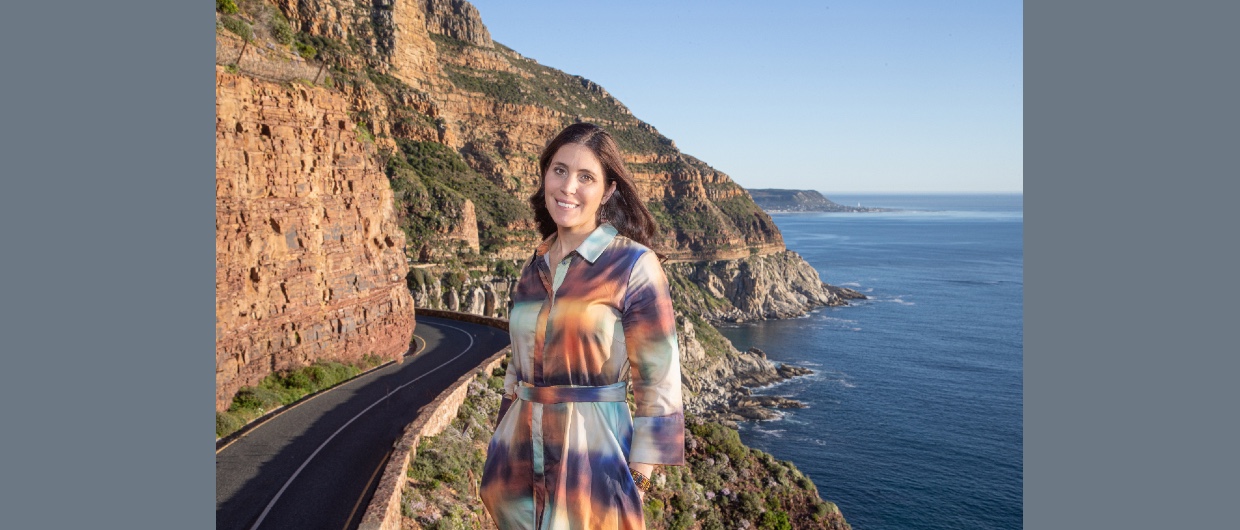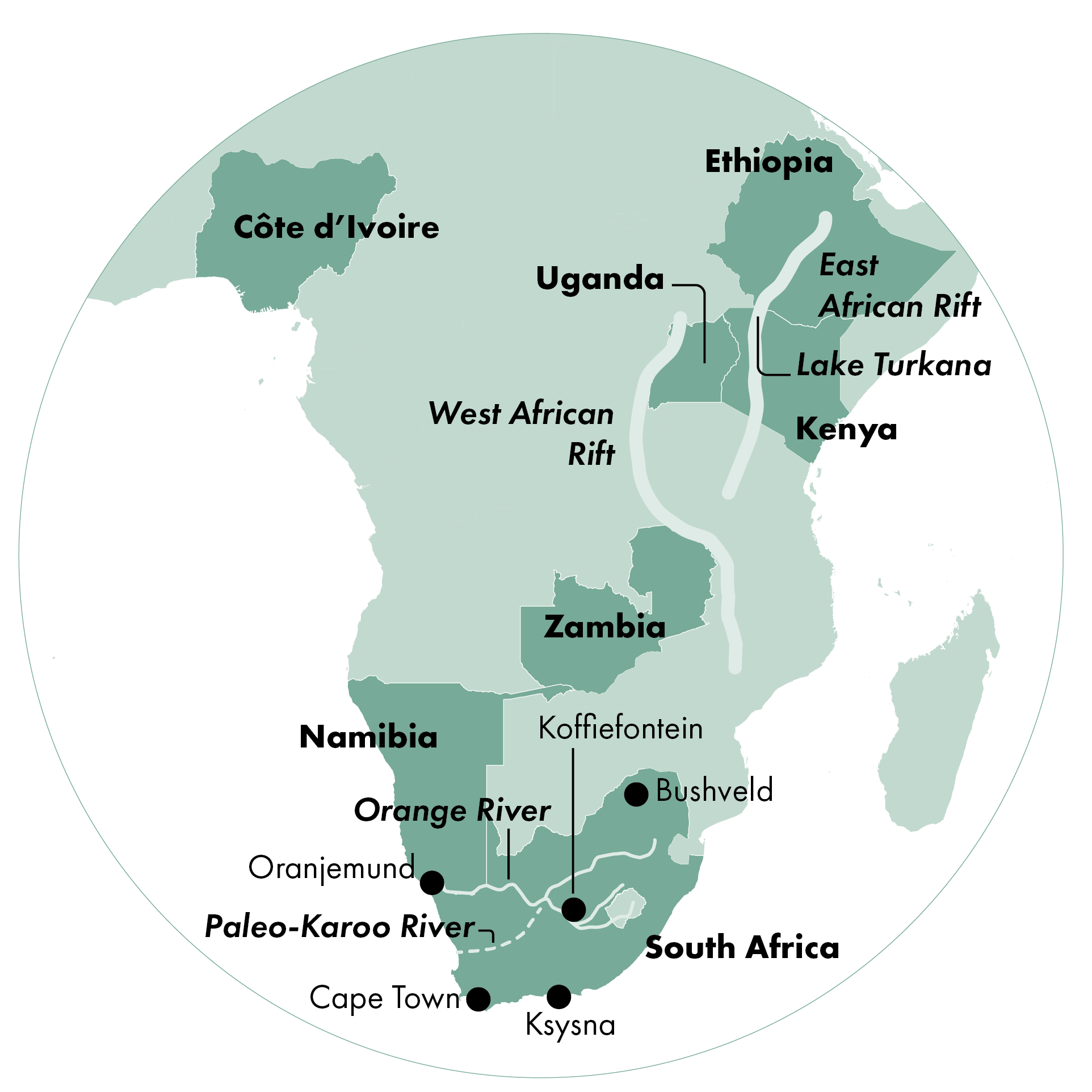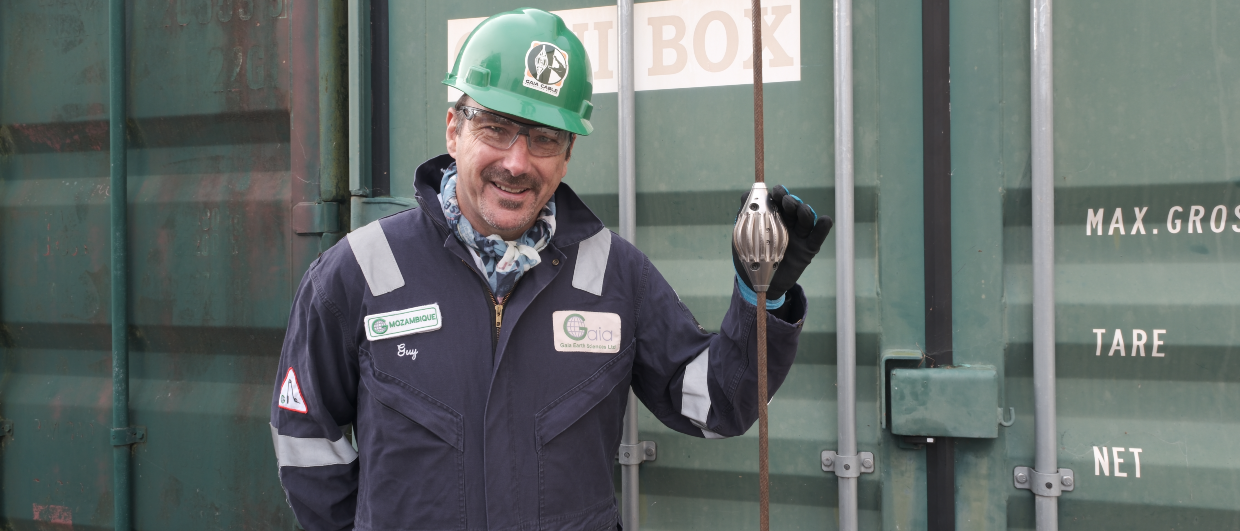“You are not going to play around here for a month and do nothing”, said Keryn’s father when she returned home to Oranjemund (Namibia) from High School for the summer holidays. He had asked the geologist at the Orange River diamond mine where he worked if his daughters could help log core samples. “It turned out that I quickly became distracted from logging, wondering off to find exotic pebbles, while my sister meticulously inspected every sample. At the end of the day, my sister did a degree in business, and I was the one pursuing a career in geoscience. My parents did not see that coming!” laughs Keryn.
Collecting crystals
Maybe Keryn’s parents could have known, though. It was at the Koffiefontein mine, one of the oldest in South Africa, dating back to 1870, that Keryn realised how fascinating geology can be. “We moved there as a family in 1987 when my father accepted an engineering position as the mine reopened.”
“As children we were always playing outdoors. One day we were making a tree house close to some historical tailings dumps, and I noticed red and green crystals sparkling in the sunshine. I collected as many as I could and spent hours washing and polishing at home. I then asked my father if he could please have them identified and valued at the mine sorthouse. The bad news was that they were not the ‘rubies and emeralds’ as I had hoped, but pyroxene and garnets instead. The note from the sorthouse explained that together with spinel and ilmenite, these crystals represent indicator minerals for kimberlite intrusions and hence for diamonds! That very real awareness of indicator minerals had me hooked!”
“Geoscientists have scientific-mathematical-naturalist expertise, the ability to understand geological processes and to create models for both prospectivity and risk. These are skills that can be leveraged across many industries.”
Picking forams
Even though Keryn’s later career would revolve around mining and petroleum exploration, her honors and master’s research focused on environmental geology instead. “I studied the microfauna (foraminifera specifically) and sediment dynamics of the Knysna Estuary, which is South Africa’s most important estuary in terms of biodiversity and conservation”, Keryn explains.
“Thesen Island had been the site of a timber factory for a long time. Developers of an exclusive marina development needed a baseline study on the water quality and flow dynamics surrounding the island. This study evolved into my master’s project, encompassing the entire 18 km long estuarine system, including the fluvial, marine and saltmarsh environments.”
No pressure
“When I was at university, we were encouraged to choose courses that would define our future career paths. Are you going to be a geophysicist, a mineralogist, a petroleum geologist, a sedimentologist? I felt more like a generalist as I appreciated many aspects of Earth Science. Looking back, this approach helped me to navigate my career, simply because global markets can be quite unpredictable, and we need to be adaptable and evolve accordingly. Geoscientists have scientific-mathematical-naturalist expertise, the ability to understand geological processes and to create models for both prospectivity and risk. These are skills that can be leveraged across many industries.”
Into the stopes
“In order to work off my bursary grant, my first job after university was in the Western Chrome Mines in the North West Province of South Africa”, Keryn continues. “The Bushveld hosts around 70% of the world’s chromium ore reserves, so while it was daunting to work underground, I appreciated the importance of the mines that are leading the global supply of this metal.”
“My main responsibility was to map the quality and thickness of the chromite layers and the distribution of faults and fracture zones so as to advise on mining operations.”
“In the year I was there, one of the mines progressed into an increasingly faulted zone. There were several occasions when I was called out at 6:00 am to map and secure a fall-of-ground (FOG), which is an incident involving a collapse of the hanging wall. You surely feel the responsibility of understanding the geology when you are accountable for the safety of all who enter the mine following a FOG.”
Offshore diamonds
Diamonds were first discovered on the Namibian coast in the early 1900s. Marine diamond mining barges were operating by the 1960s and Namibia emerged as a leader in marine diamond mining from the late 1980s.
De Beers Marine started exploring the South African coastline in 2004. “An initiative motivated by favorable market conditions and paleogeographic studies of Southern Africa”, Keryn says.

“Pre 90 Ma, a paleo-Karoo River transported diamonds eroded from Kimberlite pipes further inland towards the present-day Olifants River outlet. From around 90 Ma, this drainage system was captured by the ‘paleo-Kalahari’ River, a precursor to the modern Orange River system, shifting the diamond depocenter northwards. A combination of a northward flowing longshore current and the observation that the Early Cretaceous diamond deposits have a smaller average stone size, means that the South African Sea Areas (SASA) are more marginal than the Atlantic-1 marine mining area offshore Namibia”, explains Keryn.
“You are surrounded by cameras, and because we were not allowed to fidget, I always felt like my nose started to itch!”
“Embarking on an exploration campaign of this nature was a very exciting experience in my career”, continues Keryn. “We were looking for channels, gullies and coarser-grained deposits at water depths of around 120 m. Drillship sampling locations were planned by combining interpretation of swathe-bathymetry, chirp seismic and side-scan sonar.”
“The room on the ship where we viewed the sample product from the x-ray machine, to assess the number and size of diamonds recovered (grade), was secured to the highest standards. Only three of us were allowed to enter and all three had be to there to gain access. You are surrounded by cameras, and because we were not allowed to fidget, I always felt like my nose started to itch!”, laughs Keryn.
An important part of the mining operation is the monitoring of tool efficiency, and the impact on the marine environment. This was done by survey and ground truthing with a two-person submarine.
“Fortunately, there was no direct overlap between commercial fishing grounds or marine mammal breeding areas and 99% of the sediment mined settled back to the seabed. I was fortunate to be able to join a Jago submarine dive to the seabed. We saw that deepwater species quickly migrate back. In a way, we almost created a better environment, with the boulders reshuffling to create a sheltered habitat”, recalls Keryn.
Rising oil prices
As both oil and steel prices continued to climb from 2006 to 2008, the economic model for diamond mining offshore South Africa became harder to justify. “The most optimal pockets were mined first and as a result, cost-cutting measures were being applied everywhere”, says Keryn. It marked another turn in her career. Where offshore diamond mining was under pressure because of high oil and steel prices, another possibility opened up, and that was in the oil industry itself.
Exploring the East African Rift
At the time, Tullow Oil had discovered the Lake Albert oil fields in Uganda and was awarded frontier exploration licenses within the rift basins of Kenya and southern Ethiopia. As a result, the company was looking for exploration geologists to work up the newly obtained acreage. “All we had at the time were just a few vintage 2D seismic lines; we used those to target the very first discovery wells, Ngamia and Twiga.”
Having another opportunity to join a frontier exploration project right from the start, and to work with what were considered relatively new technologies to the upstream industry such as Full Tensor Gradiomety (FTG) and Passive Seismic was a very exciting phase of my career”, Keryn says, “and Tullow being marked as ‘most admired explorer’ also added to that.”
“When a big move seemed overwhelming, my father would ask us to give it 6 months and then reassess. I adopted this mantra throughout my career, and it certainly helped as I took on new roles and responsibilities.”
“The key geological challenge in the East African Rift (EAR) was the presence of volcanics. This contrasts the western arm of the EAR in the Albertine Graben, where volcanics are missing altogether. Volcanics impact on seismic acquisition and imagery, drilling operations and reservoir quality. There are some basins where thick volcanic successions deter exploration for potential petroleum plays.”
Give it six months
Born in the far south of Namibia, on the South African border, Keryn’s family moved to many places as her father worked on a range of mining projects while employed by De Beers. As such, it was always a challenge to move schools and build up a new life. “My parents’ advice was to “Give it your best and allow yourself some time to find your feet”. When a big move seemed overwhelming, my father would ask us to give it 6 months and then reassess. I adopted this mantra throughout my career, and it certainly helped as I took on new roles and responsibilities.”
Transferable skills
On joining Tullow, Keryn was tasked with creating paleogeographic reconstructions for the East African Rift basins. “Even though I did not have oil experience on my CV, I had transferable skills from previous work experience, such as basin modelling, fluvio-deltaic sedimentology, geophysical data interpretation and working in sensitive areas. The bottom line is that no matter what you are looking for in the subsurface, many skills are transferable from one industry to the other”, says Keryn.
Planning new seismic surveys was another aspect of Keryn’s job. “The Turkana, Lokichar, Omo and Chew Bahir basins are essentially a desert environment around freshwater lakes and rivers. The shores of Lake Turkana and the Turkwel River are renowned for archeological finds, which many consider the ‘Cradle of Mankind’. Every planned seismic line was first walked by a team that included archeological and environmental experts. This resulted in some findings, which is testament to the fact that seismic acquisition can also go hand in hand with other types of research.”
The perfect storm
Experience Keryn gained while working in the East African Rift basins led to new onshore projects in the Zambian rift basins and thereafter the Ivorian Basin of the West African Transform Margin. It was around this time that Tullow Oil suffered some disappointing operational and exploration results. Mounting financial concerns ultimately led to an announcement in February 2020 to close the Cape Town exploration office as part of a drastic move to cut costs across the business. “A month later we went into full lockdown as the COVID-19 pandemic hit, the oil price collapsed, and most new hire opportunities were frozen as global upstream companies cut budgets. It was a double whammy for sure”, Keryn says.
“Then, a former manager at Tullow Oil informed me that IHS Markit’s Plays and Basin’s team was looking for an EMEA-focused upstream research analyst and that he would be happy to refer me for the role. A number of interviews later, I was ecstatic to receive the call that my application was successful! Not only was it an interesting role in a great company, but it aligned with my career ambitions of gaining more of a birds-eye view of the upstream energy industry.”
When the time is right
Since then, Keryn has worked for what is now S&P Global, reporting on upstream energy data and trends and how investors and governments are responding to goals for the energy transition. “I’ve led research for African, Eastern Mediterranean, Caspian and North Sea basin reports. The Cape Town team has grown as well, which I am very happy about”, Keryn says.
“Looking back”, concludes Keryn, “I would say that a career is much more than the numbers on a paycheck, it’s about feeling valued and inspired. By promoting your transferable skills, focusing on what you enjoy, and leveraging esteemed connections as referrals, geoscientists have no reason to be concerned about making a move when the time is right!”





